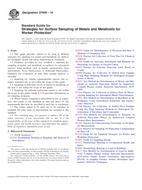Potřebujeme váš souhlas k využití jednotlivých dat, aby se vám mimo jiné mohly ukazovat informace týkající se vašich zájmů. Souhlas udělíte kliknutím na tlačítko „OK“.
ASTM D7659-10
Standard Guide for Strategies for Surface Sampling of Metals and Metalloids for Worker Protection
Automaticky přeložený název:
Standardní Guide strategií pro povrchové Odběr vzorků kovů a metaloidů pro ochranu Worker
NORMA vydána dne 1.8.2010
Informace o normě:
Označení normy: ASTM D7659-10
Poznámka: NEPLATNÁ
Datum vydání normy: 1.8.2010
Kód zboží: NS-38900
Počet stran: 11
Přibližná hmotnost: 33 g (0.07 liber)
Země: Americká technická norma
Kategorie: Technické normy ASTM
Anotace textu normy ASTM D7659-10 :
Keywords:
occupational health, occupational safety, surface sampling, surface sampling strategies, worker protection, workplace protection, ICS Number Code 13.040.30 (Workplace atmospheres)
Doplňující informace
| Significance and Use | ||||||||||||||||||||||||||||||||||||||||||
|
This guide describes approaches which can be used to determine surface sampling strategies before any actual surface sampling occurs. The strategy selection process needs to consider a number of factors, including, but not limited to, purpose for sampling, fitness of the sampling strategy for that purpose, data quality objectives and how the data will be used, ability to execute the selected strategy, and ability of the analytical laboratory (fixed-site or in-field) to analyze the samples once they are collected. For the purposes of sampling, and for the materials sampled, surface sampling strategies are matters of choice. Workplace sampling may be performed for single or multiple purposes. Conflicts may arise when a single sampling strategy is expected to satisfy multiple purposes. Limitations of cost, space, power requirements, equipment, personnel, and analytical methods need to be considered to arrive at an optimum strategy for each purpose. A strategy intended to satisfy multiple purposes will typically be a compromise among several alternatives, and will typically not be optimal for any one purpose. The purpose or purposes for sampling should be explicitly stated before a sampling strategy is selected. Good practice, regulatory and legal requirements, cost of the sampling program, and the usefulness of the results may be markedly different for different purposes of sampling. This guide is intended for those who are preparing to evaluate a workplace environment by collecting samples of metals or metalloids on surfaces, or who wish to obtain an understanding of what information can be obtained by such sampling. This guide cannot take the place of sound professional judgment in development and execution of any sampling strategy. In most instances, a strategy based on a standard practice or method will need to be adjusted due to conditions encountered in the field. Documentation of any professional judgments applied to development or execution of a sampling strategy is essential. This guide should not be used as a stand-alone document to evaluate any given contaminant or chemical species. The surface sampling techniques described in this guide are intended for the determination of metals and metalloids on surfaces, or for the determination of loadings of embedded metallic residues in surface coverings. These techniques may not accurately reflect the transferability or bioavailability of such residues by way of dermal contact or inhalation of resuspended respirable dust. |
||||||||||||||||||||||||||||||||||||||||||
| 1. Scope | ||||||||||||||||||||||||||||||||||||||||||
|
1.1 This guide provides criteria to be used in defining strategies for sampling for metals and metalloids on surfaces for workplace health and safety monitoring or evaluation. 1.2 Guidance provided by this standard is intended for sampling of metals and metalloids on surfaces for subsequent analysis using methods such as atomic spectrometry, mass spectrometry, X-ray fluorescence, or molecular fluorescence. Guidance for evaluation of data after sample analysis is included. 1.3 Sampling for volatile organometallic species (for example, trimethyl tin) is not within the scope of this guide. 1.4 Sampling to determine levels of metals or metalloids on the skin is not within the scope of this guide. 1.5 Sampling for airborne particulate matter is not within the scope of this guide. Guide E1370 provides information on air sampling strategies. 1.6 Where surface sampling is prescribed by law or regulation, this guide is not intended to take the place of any requirements that may be specified in such law or regulation. 1.7 The values stated in SI units are to be regarded as standard. No other units of measurement are included in this standard. 1.8 This standard does not purport to address all of the safety concerns, if any, associated with its use. It is the responsibility of the user of this standard to establish appropriate safety and health practices and determine the applicability of regulatory limitations prior to use. |
||||||||||||||||||||||||||||||||||||||||||
| 2. Referenced Documents | ||||||||||||||||||||||||||||||||||||||||||
|
Odebírejte informace o nově vydaných normách ZDARMA:
Chcete pravidelně odebírat informace o nově vycházejících normách z celého světa a to zcela zdarma?
Přihlašte se k odběru. Vše je velice jednoduché a absolutně ZDARMA.
Na výběr máte vydavatele z celého světa.




 Cookies
Cookies
